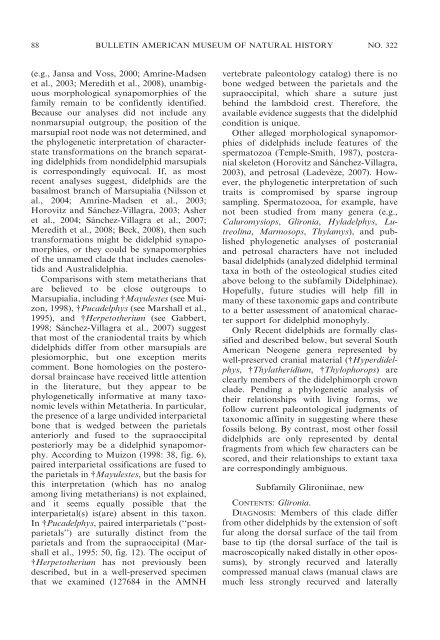phylogenetic relationships and classification of didelphid marsupials ...
phylogenetic relationships and classification of didelphid marsupials ...
phylogenetic relationships and classification of didelphid marsupials ...
You also want an ePaper? Increase the reach of your titles
YUMPU automatically turns print PDFs into web optimized ePapers that Google loves.
88 BULLETIN AMERICAN MUSEUM OF NATURAL HISTORY NO. 322<br />
(e.g., Jansa <strong>and</strong> Voss, 2000; Amrine-Madsen<br />
et al., 2003; Meredith et al., 2008), unambiguous<br />
morphological synapomorphies <strong>of</strong> the<br />
family remain to be confidently identified.<br />
Because our analyses did not include any<br />
nonmarsupial outgroup, the position <strong>of</strong> the<br />
marsupial root node was not determined, <strong>and</strong><br />
the <strong>phylogenetic</strong> interpretation <strong>of</strong> characterstate<br />
transformations on the branch separating<br />
<strong>didelphid</strong>s from non<strong>didelphid</strong> <strong>marsupials</strong><br />
is correspondingly equivocal. If, as most<br />
recent analyses suggest, <strong>didelphid</strong>s are the<br />
basalmost branch <strong>of</strong> Marsupialia (Nilsson et<br />
al., 2004; Amrine-Madsen et al., 2003;<br />
Horovitz <strong>and</strong> Sánchez-Villagra, 2003; Asher<br />
et al., 2004; Sánchez-Villagra et al., 2007;<br />
Meredith et al., 2008; Beck, 2008), then such<br />
transformations might be <strong>didelphid</strong> synapomorphies,<br />
or they could be synapomorphies<br />
<strong>of</strong> the unnamed clade that includes caenolestids<br />
<strong>and</strong> Australidelphia.<br />
Comparisons with stem metatherians that<br />
are believed to be close outgroups to<br />
Marsupialia, including {Mayulestes (see Muizon,<br />
1998), {Pucadelphys (see Marshall et al.,<br />
1995), <strong>and</strong> {Herpetotherium (see Gabbert,<br />
1998; Sánchez-Villagra et al., 2007) suggest<br />
that most <strong>of</strong> the craniodental traits by which<br />
<strong>didelphid</strong>s differ from other <strong>marsupials</strong> are<br />
plesiomorphic, but one exception merits<br />
comment. Bone homologies on the posterodorsal<br />
braincase have received little attention<br />
in the literature, but they appear to be<br />
<strong>phylogenetic</strong>ally informative at many taxonomic<br />
levels within Metatheria. In particular,<br />
the presence <strong>of</strong> a large undivided interparietal<br />
bone that is wedged between the parietals<br />
anteriorly <strong>and</strong> fused to the supraoccipital<br />
posteriorly may be a <strong>didelphid</strong> synapomorphy.<br />
According to Muizon (1998: 38, fig. 6),<br />
paired interparietal ossifications are fused to<br />
the parietals in {Mayulestes, but the basis for<br />
this interpretation (which has no analog<br />
among living metatherians) is not explained,<br />
<strong>and</strong> it seems equally possible that the<br />
interparietal(s) is(are) absent in this taxon.<br />
In {Pucadelphys, paired interparietals (‘‘postparietals’’)<br />
are suturally distinct from the<br />
parietals <strong>and</strong> from the supraoccipital (Marshall<br />
et al., 1995: 50, fig. 12). The occiput <strong>of</strong><br />
{Herpetotherium has not previously been<br />
described, but in a well-preserved specimen<br />
that we examined (127684 in the AMNH<br />
vertebrate paleontology catalog) there is no<br />
bone wedged between the parietals <strong>and</strong> the<br />
supraoccipital, which share a suture just<br />
behind the lambdoid crest. Therefore, the<br />
available evidence suggests that the <strong>didelphid</strong><br />
condition is unique.<br />
Other alleged morphological synapomorphies<br />
<strong>of</strong> <strong>didelphid</strong>s include features <strong>of</strong> the<br />
spermatozoa (Temple-Smith, 1987), postcranial<br />
skeleton (Horovitz <strong>and</strong> Sánchez-Villagra,<br />
2003), <strong>and</strong> petrosal (Ladevèze, 2007). However,<br />
the <strong>phylogenetic</strong> interpretation <strong>of</strong> such<br />
traits is compromised by sparse ingroup<br />
sampling. Spermatozooa, for example, have<br />
not been studied from many genera (e.g.,<br />
Caluromysiops, Glironia, Hyladelphys, Lutreolina,<br />
Marmosops, Thylamys), <strong>and</strong> published<br />
<strong>phylogenetic</strong> analyses <strong>of</strong> postcranial<br />
<strong>and</strong> petrosal characters have not included<br />
basal <strong>didelphid</strong>s (analyzed <strong>didelphid</strong> terminal<br />
taxa in both <strong>of</strong> the osteological studies cited<br />
above belong to the subfamily Didelphinae).<br />
Hopefully, future studies will help fill in<br />
many <strong>of</strong> these taxonomic gaps <strong>and</strong> contribute<br />
to a better assessment <strong>of</strong> anatomical character<br />
support for <strong>didelphid</strong> monophyly.<br />
Only Recent <strong>didelphid</strong>s are formally classified<br />
<strong>and</strong> described below, but several South<br />
American Neogene genera represented by<br />
well-preserved cranial material ({Hyperdidelphys,<br />
{Thylatheridium, {Thylophorops) are<br />
clearly members <strong>of</strong> the didelphimorph crown<br />
clade. Pending a <strong>phylogenetic</strong> analysis <strong>of</strong><br />
their <strong>relationships</strong> with living forms, we<br />
follow current paleontological judgments <strong>of</strong><br />
taxonomic affinity in suggesting where these<br />
fossils belong. By contrast, most other fossil<br />
<strong>didelphid</strong>s are only represented by dental<br />
fragments from which few characters can be<br />
scored, <strong>and</strong> their <strong>relationships</strong> to extant taxa<br />
are correspondingly ambiguous.<br />
Subfamily Glironiinae, new<br />
CONTENTS: Glironia.<br />
DIAGNOSIS: Members <strong>of</strong> this clade differ<br />
from other <strong>didelphid</strong>s by the extension <strong>of</strong> s<strong>of</strong>t<br />
fur along the dorsal surface <strong>of</strong> the tail from<br />
base to tip (the dorsal surface <strong>of</strong> the tail is<br />
macroscopically naked distally in other opossums),<br />
by strongly recurved <strong>and</strong> laterally<br />
compressed manual claws (manual claws are<br />
much less strongly recurved <strong>and</strong> laterally

















